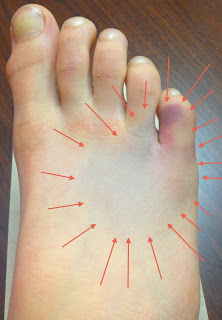 Hi My Running Doc,A couple of days ago I accidentally kicked the wall with my right foot. My foot still hurts and it is bruised. I read on your website that bruising can be a sign of a metatarsal fracture. How can I tell if it is just bruised or if my foot is actually broken? I would love to have your expert opinion!Thanks!David, Houston, Texas.Hi David, Bruising is a Bad SignIt is true that bruising is a bad sign when it comes to foot and ankle injury. When you actually fracture a bone, the bone cracks and bleeds quite a lot. That blood diffuses throughout the soft tissue under the skin. What you see is a bruise. That is part of the reason that a bruise can be so concerning for a fracture in the foot. In fact the sort of bruising pattern that the picture of your foot shows is often indicative of a fracture or broken bone in the foot. Given your pattern of bruising it is more likely that you have a metatarsal fracture or a fracture in one of the bones in the little toe such as the proximal phalanx phone. Myths about Foot Fractures1. If you can walk on the foot, it can’t be broken. FALSE!This may be one of the most widely perpetuated myths about foot injury on the Internet. I have seen many patients with serious fractures that are walking on the foot. Some patients are limping and obviously in a tremendous amount of pain while other patients with fractures or broken bones barely feel any discomfort at all. This is not a reliable indicator of whether or not you have a broken bone in your foot. 2. There is nothing you can do for a broken toe. FALSE!This is also absolutely not true. While it is true that most fractures in the toe will heal uneventfully, there are things you can do to speed healing and decrease your risk of complications. Fractures of the bones in the toe can move if not properly stabilized. Certain shoes will speed healing. Taping the toes to provide stability and immobilize the fracture will also help. But some toes should never be taped together. Without the proper treatment of a broken toe, the fracture can fail to heal leading to what physicians refer to as a nonunion. A fracture that never heals correctly can lead to pain, disability and interfere with your ability to run or even walk without pain. Occasionally patients that take the approach that “nothing can be done for fractured toe” just end up in surgery later. For the most part this is avoidable if the toe treated correctly. Diagnosis and Treatment OptionsIf you are suspicious that there might be a broken bone in your foot (or in one of your toes) it is best to figure out whether or not it is actually broken. The best option is to have an in-person evaluation by a sports medicine specialist such as a sports podiatrist. The second option is to have a remote consultation with a sports podiatrist via webcam. A third option is an attempt at self-diagnosis. This video on YouTube can show you how to perform self-diagnosis of metatarsal stress fractures. This same video would apply in your case if the pain is located where you’re bruising is in the foot. If you see a physician in person or via webcam or you perform your own self-diagnosis and think that you probably have a fracture then you should get x-rays. X-rays will not only confirm (or rule out) a broken bone in the foot but it will also give you an idea of the severity of the problem. There are some fractures that absolutely must be treated surgically. Others simply need a fracture walking boot in order to stabilize the fracture and allow it to heal. And occasionally it is necessary to use crutches. But not all fractures are the same. So if you have pain and bruising after this sort of injury and suspect that you have a fracture in your foot it is important to determine whether or not there actually is a broken bone, and treat it appropriately. As long as you treat the fracture correctly you should be able to heal and then get back to running. Dr. Christopher Segler, DPM is Board Certified, American Board of Podiatric Medicine. He believes the best podiatry practice combines cutting edge technology with the old-school convenience of house calls. He makes podiatry house calls for young active adults who want to get rid of their funky toenails as quickly as possibly. He brings the laser to homes and offices throughout the Houston Metro including the Houston Heights, The Woodlands, Baytown and Sugar Land, Texas. If you have a question about fungal toenail laser treatment, you can reach him directly at 713-489-7674.
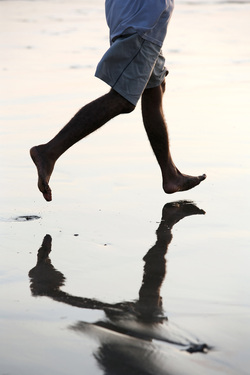 Barefoot running has increased in popularity in recent years. In fact, Dr. Segler recently lectured at a medical conference on the topic of barefoot running trends. Part of the appeal in barefoot running technique is to increase your efficiency by using more natural running biomechanics in order to hone your running form. The American Podiatric Medical Association has a position statement declaring that barefoot running is an unsafe activity and is not recommended by podiatrists. Of course not all podiatrist agree with this position. I happen to be one of those dissenting physicians. Toenail fungus is common among runners. In fact all fungal infections are common among runners. Particularly athlete's foot. Athlete's foot is nothing more than a fungus infection of the skin on the foot. A toenail fungus infection is actually caused by the same organism that causes athlete’s foot. When you run your feet sweat, moisture collects in your shoes and the ideal environment for fungal growth is created. If you run on back-to-back days the problem is compounded because your running shoes never completely dry out. If you happen to develop a case of athlete's foot, the fungus is growing between the layers of the skin. As the skin peels it sheds fungal spores into your shoes. These spores of course are the seeds from which fungus grows. If you are running, doing hill repeats or some other strenuous workout, and you repeatedly bumped the toes and the end of of the toenail on the inside of the running shoe, the fungal spores can get between the toenail and the underlying nail bed. The fungal spores begin to grow and develop into a fungal toenail infection. However when you run barefoot, you not have any risk of bumping the toenails repeatedly against an inside of a running shoe that is ripe with fungus. So in that respect, running barefoot is actually much lower risk for developing a toenail fungus infection as compared to running with running shoes. The risk is mainly related to the potential for fungal spores to collect in your shoes and then have trauma where those spores are actually in contact with the toenail in such a way that they can become embedded in or underneath the toenail and start to grow. If you are wearing minimalist running shoes such as the Vibram Five Fingers without socks the risk of developing one of these toenail infections actually increases significantly. If you start to notice discoloration such as white or yellowish spots where the toenail seems to be changing and getting thicker it could be a fungal toenail infection. Treating these infections is not really a big deal. Our podiatrist can actually bring a laser to your home or office in order to directly kill the fungus and help your toenails returned to their normal clear and healthy state. For more information on discount toenail fungus laser treatment and laser toenail fungus removal treatment visit http://www.lasertoenailhouston.com/Dr. Christopher Segler, DPM is Board Certified, American Board of Podiatric Medicine. He believes the best podiatry practice combines cutting edge technology with the old-school convenience of house calls. He makes podiatry house calls for young active adults who want to get rid of their funky toenails as quickly as possibly. He brings the laser to homes and offices throughout the Houston Metro including Downtown Houston, the Houston Heights and Sugar Land, Texas. If you have a question about fungal toenail laser treatment, you can reach him directly at 713-489-7674.
The laser treatment will kill the fungus in your toenails. But to keep your toenail clear after the laser toenail fungus treatment you have to make sure you don’t get re-infected with toenail fungus. Up to 50% of patients who effectively treat the toenail fungus infection will get the nasty infection again within a few years. The key is to keep the fungal spores under control.Spores are basically the seeds from which toenail fungus grows. They are very durable. In fact, fungal spores can lay dormant for many years and still remain viable. Just place the spores in a warm, moist, dark environment and they will start to grow sprouting a new toe fungus infection. The laser will effectively remove the fungus from your toenails, but that is only the first step. The whole time you have had a fungal infection, you have been shedding fungal spores into your shoes and socks. Getting free of the spores is the best way to prevent the fungus from infecting your toenails again. 1. Wash all of your socks in hot water. This will get rid of the fungus and spores in your socks. Some people throw out all of their socks and replace them. But this isn’t really necessary. 2. Kill the fungus in your shoes. Use an antiseptic spray or an ultraviolet sanitizer to kill the spores and live fungus in your shoes. Bowling alleys have been doing this forever. They simply spray some toxic chemicals in the bowling shoes to kill all of the germs between rentals. Sprays like Lysol will work, but frankly they make your shoes smell like Lysol. So if you are going to try this, make sure you test it out on a pair of shoes you aren’t crazy about before you spray all of your shoes. The Steri-Shoe is a much nicer alternative. It uses ultraviolet light to destroy the live fungus and spores in your shoes. No smell, no toxic chemicals and no waiting to dry the shoes out. You can order one online at a discount here. 3. Watch out for and aggressively treat any athlete’s foot. The fungus that causes athlete’s foot is the same one that causes toenail fungus infections. Those little spots of peeling skin are the classic sign of athlete’s foot. Many people think that if the skin doesn’t itch, it isn’t athlete’s foot. This is false. Every time I see a patient who wants the toenail fungus laser removal treatment I ask them if they ever get athlete’s foot. Less than 10% say yes. But about half of all the laser toenail patients actually have signs of an active case of athlete’s foot that they haven’t even noticed. So it is possible that you could pick up a case of athlete’s foot and not realize it. You should check your feet every day. Look for peeling skin around the edge of the sole and between the toes. If you get athletes foot, you are actually growing fungus between the layers of skin. As the skin peels, fungal spores are shed into your socks and shoes. Then all it takes is to bump your toenails on the inside of the shoe and those spores can get in again start another toenail fungus infection. If you notice some athlete’s foot don’t panic. You can simply apply an over-the-counter cream for a couple of weeks to cure the skin infection. Of course you will want to use the Steri-shoe ultraviolet sanitizer in your shoes again and wash your socks in hot water, just like you did after the laser procedure. Taking these simple precautions you will help ensure that your toes stay clear, healthy and fungus free! If you have a question about a toenail fungus infection, call the toenail fungus expert directly at 713-489-7674.Dr. Christopher Segler, DPM is Board Certified, American Board of Podiatric Medicine. He believes the best podiatry practice combines cutting edge technology with the old-school convenience of house calls. He makes podiatry house calls for young active adults who want to get rid of their funky toenails as quickly as possibly. He brings the laser to homes and offices throughout the Houston Metro including the Montrose, Galleria and The Woodlands, Texas. If you have a question about fungal toenail laser treatment, you can reach him directly at 713-489-7674.
If you are a runner with Achilles tendon pain and swelling that just won't go away, you should know about Platelet Rich Plasma (PRP). PRP is a new treatment alternative to surgery. It is one of the best treatment options for runners with chronic tendinitis.
The procedure is simple and not time consuming and can be performed at your home. Call 713-489-7674 today and schedule an appointment.
Dr. Christopher Segler, D.P.M. is board certified, American Board of Podiatric Medicine. His practice is limited to runners, triathletes and active young adults who want to stay active. He travels often to accommodate patients with complicated injuries in San Francisco, Houston, and Hawaii. He also provides remote consultations via Skype for injured expat patients living abroad who need expert advice, but cannot readily access a true foot and ankle expert while overseas. If you have a question about a complicated foot or ankle injury that just isn't getting better, you can reach him directly at 713-489-7674.
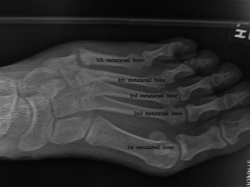 Dear MyRunningDoc, I have been ramping up my mileage as part of my marathon training. My foot has been sore and aching when I run. Someone told me that stress fractures don't normally show up on an x-ray until they start healing. If this is true, is there really any point to getting an x-ray if I think I did get a stress fracture from running too much? Adam J.Houston, TXAnswer:Great question! This is a question I often hear from runners in San Francisco and Houston. Most runners are busy and don't wont to waste their time going to a podiatry office getting an x-ray of their foot unless they really think the x-ray will change what they need to do to get the foot to stop aching and heal. (And of course, get back to running and training). But when you suspect a stress fracture, there are good reasons to get an xray. 3 reasons to get an x-ray of your foot if you think that you have a stress fracture.The 1st reason to get an xray of your foot is to make sure that the metatarsal has not actually cracked all the way through the bone or broken into pieces. The 2nd reason is to confirm that the metatarsal, if it is broken, is still in a good position that will heal correctly. If the bone is moved out of place after it has broken that it will not heal correctly and will result in what doctors call a “malunion.” When the metatarsal bone heals in an abnormal position it will alter the way that forces are distributed across the ball of the foot. An unnatural distribution of forces across the ball of the foot will put other metatarsals at risk of problems later. It can also increase the chances of nerve compression that can lead to a neuroma. The 3rd reason to get an xray of your foot when you suspect you have a stress fracture is for peace of mind. Having an x-ray confirms that the bone is not actually broken and will not likely get worse if you are walking on the foot as it heals. A fracture walking boot is made to protect a stress fracture and allow you to walk while the bone heals. if you have had an xray of the foot and confirmed that the bone is not completely broken, and you suspect that it is just a stress fracture, then you can treat it as such and feel confident you’re not going to make things significantly worse if you walk on the foot while protected in a fracture walking boot. Dr. Christopher Segler, D.P.M. is board certified, American Board of Podiatric Medicine. His practice is limited to runners, triathletes and active young adults who want to stay active. He travels often to accommodate patients with complicated injuries in San Francisco, Houston, and Hawaii. He also provides remote consultations via Skype for injured expat patients living abroad who need expert advice, but cannot readily access a true foot and ankle expert while overseas. If you have a question about a complicated foot or ankle injury that just isn't getting better, you can reach him directly at 713-489-7674.
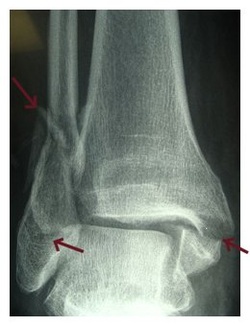 If you think you have an ankle sprain, a house call may be just what you need. Our foot award-winning foot and ankle surgeon can come right to your home or office. No need to wait for 6 hours in the Emergency Room. We can see you between meetings at work, arrange x-rays (if needed) and get you on the path to recovery. Did you know there are over 25,000 ankle sprains every day? With so many of those injured ankles showing up at the Emergency Room (along with all those with people with hacking coughs, colds and worries of swine flu) it is no wonder you might have to wait in line. Studies have shown that the average patient wait in an Emergency Room in some states is as high as 5 hours. That’s a long time to sit around just too see if anything is really broken or not.
Our ankle expert won an award from the American College of Foot Ankle Surgeons for his research on the accurate diagnosis of subtle ankle fractures. And we can bring all that expertise right to you. The good news is that ankle fractures are very rare when compared to an ankle sprain. But even an ankle sprain needs quick treatment to remove the ankle pain, swelling and bruising.
If you are a busy weekend warrior with your weekday schedule as packed as your weekend, an in-office house call by a true ankle expert might be just the ticket to get you on the road to recovery without any delays.
Dr. Christopher Segler, D.P.M. is board certified, American Board of Podiatric Medicine. His practice is limited to runners, triathletes and active young adults who want to stay active. He travels often to accommodate patients with complicated injuries in San Francisco, Houston, and Hawaii. He also provides remote consultations via Skype for injured expat patients living abroad who need expert advice, but cannot readily access a true foot and ankle expert while overseas. If you have a question about a complicated foot or ankle injury that just isn't getting better, you can reach him directly at 713-489-7674.
Hi My Running Doc!My daughter has sprained her ankles a number of times. She keeps turning her ankles and they swell up. She also seems to have this popping and clicking sound from the ankle when she walks and it's really bothering her. Questions: Why does that happen? How do we fix it? What's the surgery that she needs to cure the snapping and pain?Thanks!S.B., Berkeley, CAAnswer: Ankle sprains are the most common musculoskeletal injury. In fact, there is no sports injury that shows up in the emergency department more often in a twisted ankle. Fortunately ankle sprains heal just fine most of the time. But in some cases there can be a significant injury to the ankle that prevents them from healing properly and causes problems down the road. There are 3 primary potential causes of popping and clicking in the ankle that might be associated with persistent ankle sprains and chronic ankle instability. 1. Torn Peroneal Retinaculum 2. Lateral Process Fracture of the Talus Bone 3. Osteochondral Lesion of the Talar Dome One common cause of popping and clicking in the ankle is from dislocating or subluxing peroneal tendons. The peroneal tendons run down the back to leg behind the fibula. They turn around the end of the fibula as they curve down toward the outside of the foot. There is a thin band of tissue called the peroneal retinaculum that holds the peroneal tendons in place behind the fibula. In some cases involving ankle sprains, the peroneal tendons actually fire so hard to try to keep the foot under the leg when you roll the ankle that the perineal retinaculum actually gets torn off of the fibula bone. Because it is torn, the peroneal tendons are not held firmly in place behind the fibula. When this occurs, the peroneal tendons are free to slide forward over the leading edge of the fibula bone. As the tendons snap back and forth across the fibula, they cause a popping and clicking sound and/or sensation as you walk. When this occurs it is not always painful but it certainly can be painful. It is more worrisome if it is painful simply because this might signify a tear or a split in one of the peroneal tendons. If one of the peroneal tendons is torn or split it might need a platelet rich plasma injection (also known as a PRP injection) to help stimulate healing. If the torn peroneal tendon cannot heal on its own, it might require surgery to sew it back together. In any event pain in this area should not be ignored. Another cause of popping and clicking in the ankle can be a misdiagnosed or undiagnosed lateral process fracture of the talus bone. The talus bone is the bone that connects the top of the foot to the bottom of the ankle. Lateral process fractures are sometimes referred to as snowboarders fractures. We used to think that lateral process fractures were a rare occurrence. However Dr. Segler led a team of investigators through the largest study ever completed on lateral process fractures of the talus. He and his team won an award from the American College of Foot and Ankle Surgeons for this research. What his team found was that these fractures are about 10 times more common than previously thought. They just get missed all the time.Is Lateral process fractures are frequently misdiagnosed as ankle sprains. Yet a broken bone does not generally heal the same way as a torn ligament. If not treated correctly, the broken bone can develop into a nonunion where the bone actually never heals. When this occurs, there can be continued pain and swelling in the ankle. Sometimes there can be a popping and clicking sensation as well. The third potential cause of popping and clicking in the ankle after an ankle sprain is an osteochondral lesion of the talus. An osteochondral fracture is a crack in the bone underneath the cartilage. Basically what happens is the ankle rolls and the talus bone can tilt so far that the corner of the talar dome smacks into the tibia bone or fibular bone. If the talus has a hard enough impact as it twists, it can crack the bone and damage the cartilage. Sometimes the cartilage and the fractured piece of bone (known as an osteochondral fragment) can become loose. If not treated correctly this may not heal. If the cartilage is loose and has a flap of tissue that flips back and forth it can cause a clicking or popping sensation. This is often associated with swelling and pain in the ankle. If there is popping and clicking from the ankle, but no history of a serious ankle sprain, the shape of the fibula can potentially lead to subluxing peroneal tendons. The retinaculum might actually still be intact but because there is not a very deep groove in the back of the fibula the peroneal tendon still slide back and forth causing a popping and clicking sensation at the side of the ankle. This can cause peroneal tendinitis. If this is the case, it is possible to perform surgery to deepen the groove at the back of the fibula in order to help the peroneal tendons stay in place. This will stop the popping and clicking and prevent chronic irritation of the tendon that can lead to tears in the peroneal tendons. Another related issue with chronic ankle instability and persistently weak ankles is that the ankles can get sprained over and over. If you often find yourself rolling your ankles when walking on uneven surfaces or running on trails, the first step would be physical therapy or a home rehabilitation self-treatment program to try to strengthen the ankles and restore stability. In some cases of chronic ankle instability the ankles are so weak that the ligaments on the outside of the ankle need to be surgically repaired or rebuilt. In any case, if you have popping and clicking, especially associated with pain and swelling of the ankle, it shouldn't be ignored. Get it checked out right away. Dr. Christopher Segler, D.P.M. is board certified, American Board of Podiatric Medicine. His practice is limited to runners, triathletes and active young adults who want to stay active. He travels often to accommodate patients with complicated injuries in San Francisco, Houston, and Hawaii. He also provides remote consultations via Skype for injured expat patients living abroad who need expert advice, but cannot readily access a true foot and ankle expert while overseas. If you have a question about a complicated foot or ankle injury that just isn't getting better, you can reach him directly at 713-489-7674.
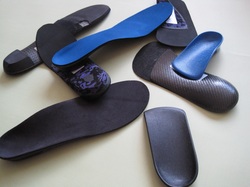 Custom orthotics are simply the best way to correct subtle imbalances in the foot and ankle that can lead to running injuries. A custom orthotic is not just an arch support or a custom foot bed with extra cushioning. A custom running orthotic is a completely custom made medical device designed to control abnormal motion, correct for alignment problems and correct faulty biomechanics that can lead to running-related injury.
When a sports medicine specialist performs your biomechanical exam, the sports medicine doctor takes numerous measurements of of the positions and angles of the feet, ankle and legs. Based on all of this information, the podiatrist makes a plaster mold of the feet and writes a prescription for the orthotic fabrication. The orthotic lab uses all of this to create an exact replica of your feet and then custom forms the orthotics device that will correct any problems in alignment. This can help to increase your running efficiency and decrease the risk of running injury.
The biggest problem for many runners in Houston is that there isn't a lot of time to waste. Because our sports medicine podiatrist is an active 11 time Ironman triathlete, marathon runner, father and busy professional, he sympathizes with the common plight of the busy Houston Area athlete. For this reason his practice is dedicated exclusively to house calls for runners in the Houston Metro, Inner Loop, Montrose, Galleria, and Houston Heights.
If you need custom orthotics, he will come right to your home or office to perform your biomechanical exam and cast you for your custom running orthotics. He will even personally deliver the orthotics to you. That way you won't have to skip a business luncheon or afternoon run just to see an expert. Let the expert come to you!
Dr. Christopher Segler, DPM is board certified, American Board of Podiatric Medicine. He believes that the best medicine can be fast, convenient and low-cost treatment. His innovative housecall podiatry practice model helps to keep costs down for patient with making expert care more convenient than ever.
If you have a tight work schedule we can even see you in your own office. We often do house calls for executives so that they can be seen between meetings. When there is no time to waste, a house call is definitely the best treatment and just what the doctor ordered!
We offer house calls all over the Houston area, including the Galleria Area, West University, Bellaire, Southside Place, Downtown Houston, Midtown Houston, Uptown Houston, Memorial, Montrose, Houston Heights, and Washington Heights.
If you have a question about toenail fungus and wonder whether or not the laser fungus removal treatment might be right for you, you can call and speak directly with a toenail expert by calling 713-489-7674. And yes, you will actually get to speak with the doctor.
Hi “My Running Doc!”
I recently read the book “Born to Run.” after reading it, I became intrigued and have decided to try some minimalist running shoes. However a lot of stuff that I read online says that might get injured if I run barefoot or in minimalist shoes.
As a little background, I am experienced marathon runner and have been running for decades. I have a neutral foot type and never had any serious running injuries.
Do you have any recommendations on how to safely choose minimalist running shoes so I can run with a more natural running form to convert to more of a minimalist style?
Thanks!
Peter
San Francisco, CA
Hello Peter,
Great question! There are a number of different types of minimal running shoes that you can choose from. But before you can make a reasonable choice on which you would be right for you you have to understand the basics of “minimalist shoes.”
I define a minimalist running shoe as one that has lightweight construction, minimal support and a decreased forefoot to rearfoot drop.
In case you’re not familiar with minimalist running shoe construction is important to point out that the “ forefoot to rearfoot drop” is the difference in height of the heel as compared to the forefoot. Standing barefoot is a 0° drop. A running shoe with a zero-degree drop is flat. Any shoe that has no more supporting material under the heel than under the forefoot will have a 0° drop.
A standard running shoe has a 12 mm drop. This means that there is 12 mm of material under the heel, lifting the heel up relative to the forefoot. Proponents of minimalist running argue that all this extra material under your heel is what forces you to land as a heel striker when you run in these type of running shoes.  Vibram FiveFingers® are the shoes that many people think of when they hear about barefoot running. The argument for this type of shoe is that you get the most sensitive ground feel, and hence a running experience that is the most consistent with true barefoot running. However you are protected by a pliable rubber outsole. These shoes certainly fit the criteria of a minimalist shoe in that they have very little support, they’re very light weight and they have a zero-degree drop (meaning the heel is no higher than the toes.) Given that most people are accustomed to walking and running in shoes that have a slightly elevated heel, they can at risk of injuries like Achilles tendinitis and even potentially stress fractures if they switch to rapidly to a barefoot running style.
 There are other shoes however which will help you learn how to run without the drastic change in forefoot to rearfoot drop. Another extremely popular minimalist running shoe is the Saucony Kinvara. The Kinvara has a 4mm drop, is very light (7.7 oz.) and is very supple. it allows a good ground feel and lends itself the natural running form however it still maintains a modest amount of support. It allows a bit of insurance in the sense that if reform starts to fall apart and you begin to convert into a heel striker you at least have some cushion to protect you.
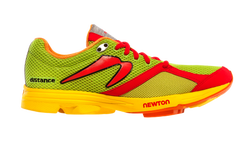 Another good option is Newton Running shoes. Newton’s are unique in that they have elastomeric lugs under the forefoot that help encourage you to land as more as a forefoot or midfoot striker. For a neutral runner like yourself, the Newton Gravity Trainer would be a good choice. It weighs 9.1 ounces and has a 3mm forefoot to rearfoot drop. Newton running shoes are designed specifically with the intent to help runners learn how to convert to more of a natural running style. In fact Danny Abshire, the founder of the company is also authored a book which helps teach runners to convert their running style away from heel striking to potentially more efficient stride. I think Danny has the right approach. I myself run in Newton running shoes for speed workouts and for tempo runs. However I also incorporate a couple of different kinds of running shoes based on the workouts that I am doing. I run in Kinvaras for some moderate runs. I also run a more of a typical cushioning type of running shoe when I do long runs, or any run where I expect that I might walk. Reason for this is simple. Most people it is spent their lives in elevated heel shoes can develop a tight Achilles tendon. Walking in shoes with a 0° drop can lead to Achilles tendinitis quite rapidly. As someone who trains continually and almost always has an Ironman on the schedule I can afford to develop any issues. I consider using multiple types of running shoes as cross training for my feet. I believe it decreases the risk of injury. If barefoot running form is a new adventure I hope you will find it to be helpful in developing a more efficient stride and ultimately a more enjoyable running experience.
Dr. Christopher Segler, DPM is board certified, American Board of Podiatric Medicine. He believes that the best medicine can be fast, convenient and low-cost treatment. His innovative housecall podiatry practice model helps to keep costs down for patient with making expert care more convenient than ever.
If you have a tight work schedule we can even see you in your own office. We often do house calls for executives so that they can be seen between meetings. When there is no time to waste, a house call is definitely the best treatment and just what the doctor ordered!
We offer house calls all over the Houston area, including the Galleria Area, West University, Bellaire, Southside Place, Downtown Houston, Midtown Houston, Uptown Houston, Memorial, Montrose, Houston Heights, and Washington Heights.
If you have a question about toenail fungus and wonder whether or not the laser fungus removal treatment might be right for you, you can call and speak directly with a toenail expert by calling 713-489-7674. And yes, you will actually get to speak with the doctor.
|




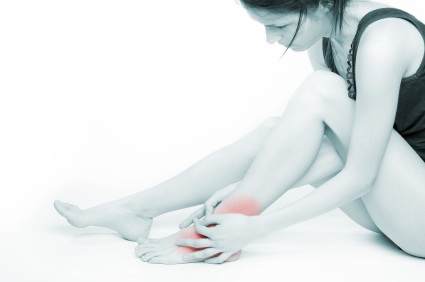




 RSS Feed
RSS Feed